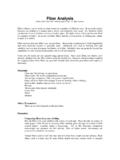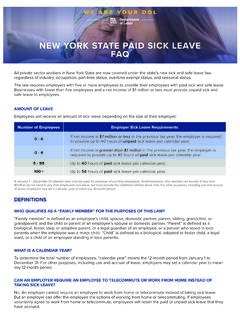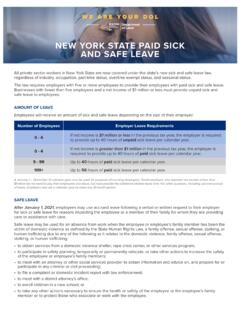Transcription of WRITING CHEMICAL EQUATIONS
1 WRITING CHEMICAL EQUATIONS . 2019, 2004, 2002, 1989 by David A. Katz. All rights reserved. Permission for classroom used provided original copyright is included. David A. Katz Chemist, Educator, Science Communicator, and Consultant I. THE MEANING OF A CHEMICAL EQUATION. A CHEMICAL equation is a chemist's shorthand expression for describing a CHEMICAL change. As an example, consider what takes place when iron rusts. The equation for this change is: Fe + O2 Fe2O3. In this expression, the symbols and formulas of the reacting substances, called the reactants, are written on the left side of the arrow and the products of the reaction are written on the right side.
2 The arrow is read as gives , yields , or forms and the plus (+) sign is read as and . When the plus (+) sign appears between the formulas for two reactants, it can be read as reacts with . (The + sign does not imply mathematical addition.). The equation, above, can be read as iron reacts with oxygen to yield (or form) iron(III) oxide. II. BALANCING A CHEMICAL EQUATION. As it is written, the equation indicates in a qualitative way what substances are consumed in the reaction and what new substances are formed. In order to have quantitative information about the reaction, the equation must be balanced so that it conforms to the Law of Conservation of Matter.
3 That is, there must be the same number of atoms of each element on the right hand side of the equation as there are on the left hand side. If the number of atoms of each element in the equation above are counted, it is observed that there are 1 atom of Fe and 2 atoms of O on the left side and 2 atoms Fe and 3 atoms of O on the right. Fe + O2 Fe2O3. Left side: Right side: 1 atom Fe 2 atoms Fe 2 atoms O 3 atoms O. The balancing of the equation is accomplished by introducing the proper number or coefficient before each formula. To balance the number of O atoms, write a 3 in from of the O2 and a 2 in front of the Fe2O3: Fe + 3 O2 2 Fe2O3.
4 The equation, above, now has 6 atoms of O on each side, but the Fe atoms are not balanced. Since there is 1 atom of Fe on the left and 4 atoms of Fe on the right, the Fe atoms can be balanced by WRITING a 4 in front of the Fe: 4 Fe + 3 O2 2 Fe2O3. This equation is now balanced. It contains 4 atoms of Fe and 6 atoms of O on each side of the equation. The equation is interpreted to mean that 4 atoms of Fe will reaction with 3 molecules of O2 to form 2 molecules of Fe2O3. It is important to note that the balancing of an equation is accomplished by placing numbers in front of the proper atoms or molecules and not as subscripts.
5 In an equation, all CHEMICAL species appear as correct formula units. The addition (or change) of a subscript changes the meaning of the formula unit and of the equation. Coefficients in front of a formula unit multiply that entire formula unit. Another example of balancing an equation is: Al(OH)3 + H2SO4 Al2(SO4)3 + H2O. counting the atoms of each element in the equation it is found that there are 1 atom Al, 7 atoms O, 5 atoms H, and 1. atom s on the left side and 2 atoms Al, 13 atoms O, 2 atoms H, and 3 atoms S on the right side. Al(OH)3 + H2SO4 Al2(SO4)3 + H2O. Left side: Right side: 1 atom Al 2 atoms Al 7 atoms O 13 atoms O.
6 5 atoms H 2 atoms H. 1 atom s 3 atoms S. The counting , however, can be simplified by observing that the S and O in the SO4 polyatomic ion acts as a single unbreakable unit in this equation. Recounting, using the SO4 as a single unit, it is found that there are 1 atom Al, 3. atoms O, 5 atoms H, and 1 SO4 polyatomic ion on the left side and 2 atoms Al, 1 O atom, 2 H atoms, and 3 SO4. polyatomic ions on the right side. Al(OH)3 + H2SO4 Al2(SO4)3 + H2O. Left side: Right side: 1 atom Al 2 atoms Al 3 atoms O 1 atoms O. 5 atoms H 2 atoms H. 1 SO4 group 3 SO4 groups Starting with Al, the atoms of Al can be balanced by WRITING a 2 in front of the Al(OH)3: 2 Al(OH)3 + H2SO4 Al2(SO4)3 + H2O.
7 Looking at the SO4 ions, these are balanced by WRITING a 3 in front of the H2SO4: 2 Al(OH)3 + 3 H2SO4 Al2(SO4)3 + H2O. Now, only the O atoms and H atoms remain unbalanced. There are 6 atoms of O and 12 atoms of H on the left hand side of the equation and only 1 atom O and 2 atoms H on the right side. These can be balanced by WRITING a 6 in front of the H2O: 2 Al(OH)3 + 3 H2SO4 Al2(SO4)3 + 6 H2O. The equation is now balanced and it is interpreted to mean that 2 molecules of Al(OH)2 react with 3 molecules of H2SO4 to form 1 molecule of Al2(SO4)3 and 6 molecules H2O. 2. Problems: Balancing CHEMICAL EQUATIONS Balance each of the following EQUATIONS : 1.
8 H2 + Br2 HBr 2. N2 + H2 NH3. 3. Sb + O2 Sb4O6. 4. Cu(NO3)2 CuO + NO2 + O2. 5. (NH4)2Cr2O7 Cr2O3 + N2 + H2O. 6. C2H6 + O2 CO2 + H2O. 7. Al + HgCl2 AlCl3 + Hg 8. FeS + O2 Fe2O3 + SO2. 9. KOH + Cl2 KCl + KClO + H2O. 10. Ca(OH)2 + H3PO4 Ca3(PO4)2 + H2O. 11. BaCl2 + Na2SO4 BaSO4 + NaCl 12. CrBr3 + Na2 SiO3 Cr2(SiO3)3 + NaBr Not all EQUATIONS can be easily balanced by the method used here. In some EQUATIONS the oxidation numbers of some atoms change during the reaction. Such EQUATIONS are known as oxidation-reduction EQUATIONS and many of these require special methods to balance them. Although the balancing of oxidation-reduction EQUATIONS will not be covered in this tutorial, the following oxidation reduction equation is provided as an exercise: Balance the following equation: Cu + HNO3 Cu(NO3)2 + NO + H2O.
9 3. III. TYPES OF CHEMICAL REACTIONS. Most inorganic reactions can be classified into one of five general categories: direct union or combination, decomposition, displacement, metathesis or double displacement, and combustion reactions. Each of these will be discussed in more detail in the following sections. 1. Direct Union or Combination Reactions Any reaction in which two or more substances combine to form a single product is a direct union or combination reaction. The general form of a direct union reaction is A + B AB. This type of reaction generally takes place between the following types of compounds: a. A metal + non-metal 2 Na + Cl2 2 NaCl sodium chloride Fe + S FeS.
10 Iron(II) sulfide b. Metal oxide + non-metal oxide K2O + SO3 K2SO4. potassium sulfur potassium oxide trioxide sulfate CaO + CO2 CaCO3. calcium carbon calcium oxide dioxide carbonate c. Non-metal + non-metal C + O2 CO2. carbon dioxide N2 + 3 Cl2 2 NCl3. nitrogen trichloride 2. Decomposition Reactions Decomposition is the reverse of combination. That is, a single reactant is broken down into two or more products either elements or compounds. A decomposition reaction will take place because the compound is unstable or as a result of heating or electrical decomposition (electrolysis). The general form for a decomposition reaction is: AB A + B.












